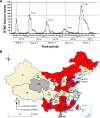New Threats from H7N9 Influenza Virus: Spread and Evolution of High- and Low-Pathogenicity Variants with High Genomic Diversity in Wave Five
- PMID: 29563296
- PMCID: PMC5952148
- DOI: 10.1128/JVI.00301-18
New Threats from H7N9 Influenza Virus: Spread and Evolution of High- and Low-Pathogenicity Variants with High Genomic Diversity in Wave Five
Abstract
H7N9 virus has caused five infection waves since it emerged in 2013. The highest number of human cases was seen in wave 5; however, the underlying reasons have not been thoroughly elucidated. In this study, the geographical distribution, phylogeny, and genetic evolution of 240 H7N9 viruses in wave 5, including 35 new isolates from patients and poultry in nine provinces, were comprehensively analyzed together with strains from first four waves. Geographical distribution analysis indicated that the newly emerging highly pathogenic (HP) and low-pathogenicity (LP) H7N9 viruses were cocirculating, causing human and poultry infections across China. Genetic analysis indicated that dynamic reassortment of the internal genes among LP-H7N9/H9N2/H6Ny and HP-H7N9, as well as of the surface genes, between the Yangtze and Pearl River Delta lineages resulted in at least 36 genotypes, with three major genotypes (G1 [A/chicken/Jiangsu/SC537/2013-like], G3 [A/Chicken/Zhongshan/ZS/2017-like], and G11 [A/Anhui/40094/2015-like]). The HP-H7N9 genotype likely evolved from G1 LP-H7N9 by the insertion of a KRTA motif at the cleavage site (CS) and then evolved into 15 genotypes with four different CS motifs, including PKG
Keywords: H7N9; HPAIV; avian influenza virus; dynamic reassortment; evolution; genetic diversity; origin; wave five.
Copyright © 2018 American Society for Microbiology.
Figures




Similar articles
-
Genesis and Spread of Newly Emerged Highly Pathogenic H7N9 Avian Viruses in Mainland China.J Virol. 2017 Nov 14;91(23):e01277-17. doi: 10.1128/JVI.01277-17. Print 2017 Dec 1. J Virol. 2017. PMID: 28956760 Free PMC article.
-
Emergence and Adaptation of a Novel Highly Pathogenic H7N9 Influenza Virus in Birds and Humans from a 2013 Human-Infecting Low-Pathogenic Ancestor.J Virol. 2018 Jan 2;92(2):e00921-17. doi: 10.1128/JVI.00921-17. Print 2018 Jan 15. J Virol. 2018. PMID: 29070694 Free PMC article.
-
Co-circulation of multiple genotypes of influenza A (H7N9) viruses in eastern China, 2016-2017.Arch Virol. 2018 Jul;163(7):1779-1793. doi: 10.1007/s00705-018-3800-3. Epub 2018 Mar 14. Arch Virol. 2018. PMID: 29541846
-
The Effects of Genetic Variation on H7N9 Avian Influenza Virus Pathogenicity.Viruses. 2020 Oct 28;12(11):1220. doi: 10.3390/v12111220. Viruses. 2020. PMID: 33126529 Free PMC article. Review.
-
Epidemiology, Evolution, and Pathogenesis of H7N9 Influenza Viruses in Five Epidemic Waves since 2013 in China.Trends Microbiol. 2017 Sep;25(9):713-728. doi: 10.1016/j.tim.2017.06.008. Epub 2017 Jul 19. Trends Microbiol. 2017. PMID: 28734617 Review.
Cited by
-
Enhanced Potency of a Broad H7N9-Neutralizing Antibody HNIgGA6 Through Structure-Based Design.Front Microbiol. 2020 Jun 19;11:1313. doi: 10.3389/fmicb.2020.01313. eCollection 2020. Front Microbiol. 2020. PMID: 32636820 Free PMC article.
-
Surveillance of avian influenza viruses in live bird markets of Shandong province from 2013 to 2019.Front Microbiol. 2022 Nov 3;13:1030545. doi: 10.3389/fmicb.2022.1030545. eCollection 2022. Front Microbiol. 2022. PMID: 36406436 Free PMC article.
-
L226Q Mutation on Influenza H7N9 Virus Hemagglutinin Increases Receptor-Binding Avidity and Leads to Biased Antigenicity Evaluation.J Virol. 2020 Sep 29;94(20):e00667-20. doi: 10.1128/JVI.00667-20. Print 2020 Sep 29. J Virol. 2020. PMID: 32796071 Free PMC article.
-
Correlates of disease severity in bluetongue as a model of acute arbovirus infection.PLoS Pathog. 2024 Aug 16;20(8):e1012466. doi: 10.1371/journal.ppat.1012466. eCollection 2024 Aug. PLoS Pathog. 2024. PMID: 39150989 Free PMC article.
-
The Pandemic Threat of Emerging H5 and H7 Avian Influenza Viruses.Viruses. 2018 Aug 28;10(9):461. doi: 10.3390/v10090461. Viruses. 2018. PMID: 30154345 Free PMC article. Review.
References
-
- Gao R, Cao B, Hu Y, Feng Z, Wang D, Hu W, Chen J, Jie Z, Qiu H, Xu K, Xu X, Lu H, Zhu W, Gao Z, Xiang N, Shen Y, He Z, Gu Y, Zhang Z, Yang Y, Zhao X, Zhou L, Li X, Zou S, Zhang Y, Yang L, Guo J, Dong J, Li Q, Dong L, Zhu Y, Bai T, Wang S, Hao P, Yang W, Han J, Yu H, Li D, Gao GF, Wu G, Wang Y, Yuan Z, Shu Y. 2013. Human infection with a novel avian-origin influenza A (H7N9) virus. N Engl J Med 368:1888–1897. doi:10.1056/NEJMoa1304459. - DOI - PubMed
-
- Liu D, Shi W, Shi Y, Wang D, Xiao H, Li W, Bi Y, Wu Y, Li X, Yan J, Liu W, Zhao G, Yang W, Wang Y, Ma J, Shu Y, Lei F, Gao GF. 2013. Origin and diversity of novel avian influenza A H7N9 viruses causing human infection: phylogenetic, structural, and coalescent analyses. Lancet 381:1926–1932. doi:10.1016/S0140-6736(13)60938-1. - DOI - PubMed
-
- Gao HN, Lu HZ, Cao B, Du B, Shang H, Gan JH, Lu SH, Yang YD, Fang Q, Shen YZ, Xi XM, Gu Q, Zhou XM, Qu HP, Yan Z, Li FM, Zhao W, Gao ZC, Wang GF, Ruan LX, Wang WH, Ye J, Cao HF, Li XW, Zhang WH, Fang XC, He J, Liang WF, Xie J, Zeng M, Wu XZ, Li J, Xia Q, Jin ZC, Chen Q, Tang C, Zhang ZY, Hou BM, Feng ZX, Sheng JF, Zhong NS, Li LJ. 2013. Clinical findings in 111 cases of influenza A (H7N9) virus infection. N Engl J Med 368:2277–2285. doi:10.1056/NEJMoa1305584. - DOI - PubMed
-
- Cowling BJ, Jin L, Lau EH, Liao Q, Wu P, Jiang H, Tsang TK, Zheng J, Fang VJ, Chang Z, Ni MY, Zhang Q, Ip DK, Yu J, Li Y, Wang L, Tu W, Meng L, Wu JT, Luo H, Li Q, Shu Y, Li Z, Feng Z, Yang W, Wang Y, Leung GM, Yu H. 2013. Comparative epidemiology of human infections with avian influenza A H7N9 and H5N1 viruses in China: a population-based study of laboratory-confirmed cases. Lancet 382:129–137. doi:10.1016/S0140-6736(13)61171-X. - DOI - PMC - PubMed
Publication types
MeSH terms
Substances
LinkOut - more resources
Full Text Sources
Other Literature Sources
Medical
Research Materials
Miscellaneous

